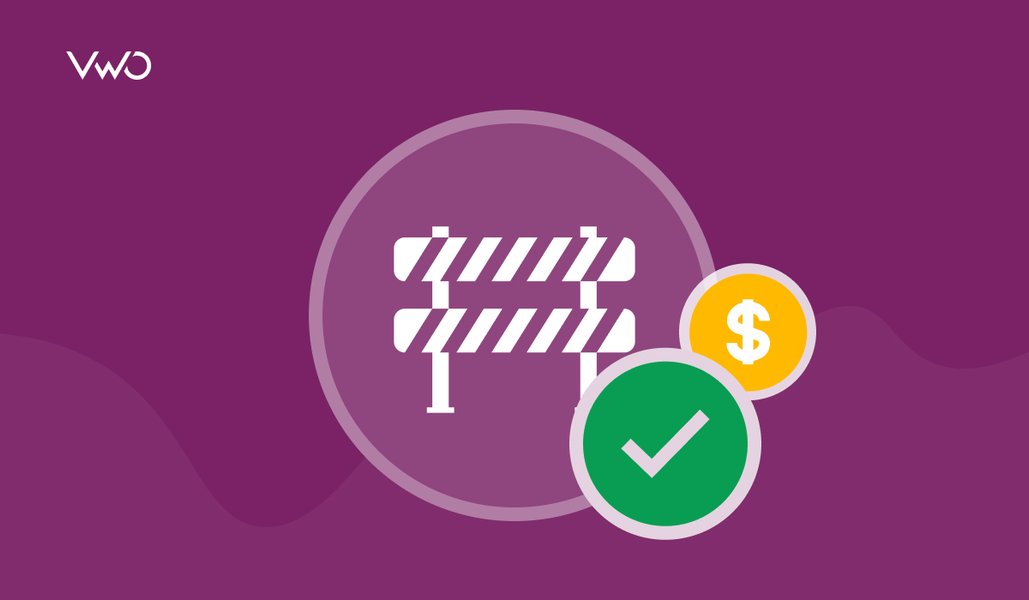When you start to work with a new client or build an experimentation culture in your org, one of the easiest ways to get buy-in is by communicating the potential Return on Investment (ROI) from this program. Return on Investment is the language of your bosses. There’s no easier way to measure a decision than to see what you gain and may lose from it.
ROI is even more important today. Interest rates keep rising, meaning there’s no more cheap money. Growth at all costs is forgotten, and leadership is more careful with the budget as they search for cheaper solutions in marketing and other areas. Here’s where basing your testing on ROI can get you support. Using ROI also lets you:
- Measure the profitability of investments
- Show concrete data to support decisions
- Demonstrate (especially to those new to experimentation) that testing can have a positive impact on the bottom line
Once you convince stakeholders that there is money behind experimentation, you can focus on expanding and nurturing the culture.
How to estimate potential ROI from experimentation

Creating an ROI benchmark model like the Where and How Should I Test to Make the Most Money Blueprint above is one of the first steps to understanding how much to invest in an experimentation program and communicating revenue goals to your leadership. From this table, you’ll be able to tie “potential revenue” to each A/B test idea, and you can use this as a mechanism to prioritize tests.
This is a custom model based on your traffic and conversion numbers. It will take your AOV into account and show you the impact you will have after the test. If this impact (minimum detectable effect, MDE) is reached, how would it affect the revenue?
A SaaS version of this should use a “Pipeline Value Calculation” financial model as seen here

If you want to understand the potential impact of a single A/B test that you are about to run, the easiest way is to use an A/B test calculator. In order to be able to do it, follow the below steps:
1. Gather the necessary data
- Traffic: Identify the amount of traffic (visitors) going to the webpage or app where the test will run. Remember to look at that specific audience (device, source, etc if it is a targeted test).
- Conversion rate (CR): Note the current conversion rate (the percentage of visitors who complete the desired action).
- Average order value (AOV): Calculate the average amount a customer spends per transaction on your site.
- Minimum detectable effect (MDE): Estimate the smallest change in the conversion rate that would make a test result meaningful.
2. Use an A/B test calculator
Once you have the required data, enter it into an A/B test calculator. The calculator will estimate:
- Sample size: The number of visitors you need to observe during the test to obtain statistically significant results.
- Test duration: How long a test has to run to gather enough data for reliable conclusions.
- Confidence level: Most calculators use a default of 95%, meaning there’s a 95% chance the results are not due to random variations.
3. Calculate the potential ROI
To determine the ROI from your A/B test, use the following formula:
Revenue Impact = AOV x Additional Conversions.
Here, Additional Conversions refers to the increase in conversions resulting from the test. This is typically derived from your calculated MDE: Additional Conversions = Current Conversions x (New Conversion Rate – Old Conversion Rate / 100).
This way you can determine the potential ROI from that specific A/B test. Combining the specific A/B test analysis with the ROI Benchmark table, you might end up changing your strategy and focusing on other swimlanes: for example one closer to the conversion point.
Where to showcase ROI – A/B test scorecards

Creating individual testing scorecards with ROI estimates is a powerful way to communicate the impact of your A/B tests and experiments to key stakeholders, especially leadership teams.
These scorecards also help standardize how you present data, making it easier and faster for decision-makers to understand the outcomes and value of your tests.
In the picture, you can see Speero’s test scorecard, which we use for all of our clients. We’ve even automated their creation and sharing via Airtable+Zapier+Slack so our clients get them automatically in their Slack channel when the test results have been analyzed. What you’ll include in your card will be different, based on your business needs. Ours include:
- Primary metric
- Problem/Opportunity based on research
- Test hypothesis
- Outcome/Takeaway which can be win, loss, flat, or error.
- Estimated monetary contribution if the MDE is hit
- ‘Discovered revenue’ based on effect. This is the measured effect (win or save)
- Wireframes of the control and the variant (done in Figma).
- A/B test discovered revenue: XX
Including ROI estimates in your scorecards translates your testing outcomes into a language that everyone in the company understands—revenue. Upper management often cares most about the bottom line, and ROI-based scorecards allow you to demonstrate how your tests contribute to financial goals. This strengthens the case for future experimentation and justifies your testing budget.
These scorecards can also serve as a summary tool for quarterly reports, where you review multiple tests together to show cumulative impact. Which brings us to the next chapter:
(ROI) Quarterly business reviews

QBRs let you review the last three months of performance and the next three months of strategy with the client, as well as assess program gaps, opportunities, upcoming goals, and more. You can not only showcase ROI in quarterly business reviews, but also highlight key metrics and trends, and track performance to particular business goals.
For the presentation, you should schedule a 45-60 minute meeting with relevant stakeholders. Make this a priority for a successful QBR presentation, since you’ll likely invite a bigger group from the client side to attend (including senior and C-level), which means it gets really challenging to synchronize on availability.
Try to deliver the information within the deck in less than 30 minutes to keep the attendees more engaged, and ask them to write the questions down for the season’s end to maintain the flow.
There’s a big list of possible topics you can include in your QBR:
- ROI for tests
- Quarter goals and if they were achieved
- Upcoming quarter objectives
- Avg. test throughput time
- Test and research scorecards (in the appendix)
- For a bigger program theme analysis in terms of wins & losses
- Discuss and plan the strategy for the next quarter
- Program statistics
The Program statistics slide(s) is a key element to elaborate the QBR storytelling. This gives you an overview of what was achieved in terms of testing and program velocity and will directly affect how the rest of the information is presented.
Additionally, you could add the summary of experiments (Key Customer Learnings) to the deck, as well as link all scorecards to the appendix. Some more great tips:
- Use visuals to make data more engaging.
- Use Airtable to track and showcase ROI over time
- Update data regularly
Why should I believe you?
The main issue with showcasing ROI is that it’s not precise but an estimate. The most accurate numbers are when you just look at the test run time and the extra revenue generated during that time. This is one field in our Airtable repository for example as discovered revenue and it can be either positive or negative. It is effective as a negative number especially when the test idea has been politically driven or a change that was going to be implemented.
You could also estimate and project ROI over a course of time, but to create those models you need buy-in and intimate work with your finance team to increase trust. The most typical model we use and have seen the clients’ companies agreeing to is projecting revenue over the next 12 months with a decay of 20% (to get a more accurate decay for your business, you can ask for data from your A/B testing tool) that kicks in after month 3.
Here is an example of an ROI model that was based on results for a Beauty E-commerce brand, it follows the above formula and includes all discovered revenue either positive or negative.

To combat client skepticism about ROI, you need a structured approach that shows the value of experimentation. Here’s how:
Show the potential impact of not implementing CRO
Start by illustrating the consequences of zero optimization. Many companies fail to recognize the revenue they could be losing without CRO. By explaining that missed opportunities mean potential revenue left “on the table,” you create FOMO, and an even bigger problem is implementing changes that can hurt the website conversion rates.
Use data storytelling to highlight ROI
You can often present great numbers that don’t resonate with your leadership team. Instead, use data storytelling to connect with them on an emotional and logical level. Share past examples, real-life scenarios, or hypothetical projections to show how similar businesses achieved success with CRO.
Include elements like before-and-after metrics, revenue increases, and real-life improvements that speak directly to your leadership and their business goals. This narrative helps translate complex data into stories that support ROI with relatable outcomes.
Leverage holdback groups to prove test impact
Some companies use holdback groups to prove or disprove test impact over time. This requires a lot of traffic though and in many cases, it hasn’t shown enough benefits, and companies revert back to using that traffic for new changes and testing.
Regularly update and share ROI metrics
Skepticism can stem from a lack of visibility into the ongoing performance of experiments. Address this by regularly updating your management team with ROI metrics. Quarterly Business Reviews (QBRs) and automatic distribution of test reports on chat, which your company uses, are great tools for this (We use Airtable + Zapier + Slack).
During these updates, present the estimated ROI, test duration, conversions, and other KPIs. Over time, clients gain a deeper understanding of how each experiment ties back to revenue and business goals. Establishing a consistent cadence for these reports also reinforces the value of CRO as a long-term strategy, rather than a one-time activity.
Align with client goals using Goal tree mapping
In addition to regular updates, consider aligning your experimentation metrics with client goals through a Goal Tree Mapping workshop. By mapping out how individual metrics (such as add-to-cart rates or lead captures) link to the client’s high-level goals, you emphasize how CRO directly contributes to the client’s overall vision. Goal Tree Mapping transforms ROI metrics from abstract numbers into clear contributors toward achieving strategic objectives, making it easier for clients to see the direct value of experimentation.
Establish long-term value and experimentation culture
Encourage clients to see CRO as part of a larger culture of experimentation within their organization. A long-term approach promotes continuous improvement and positions CRO as an essential business strategy rather than a series of isolated tests. By fostering this mindset, clients begin to recognize the compound benefits of consistent testing and optimization over time, making it easier to justify investment in CRO for ongoing growth.
Why ROI matters
Showing ROI in experimentation isn’t just about numbers; it’s about making results relatable and actionable for everyone involved. When you focus on ROI-driven experimentation, you clarify the financial impact of each test, proving to your stakeholders that your efforts directly support the bottom line.
This lets you turn experimentation from isolated tests into a core business practice, fostering a culture where experimentation is understood and appreciated across the board. By regularly tracking and sharing ROI metrics, you build transparency and trust, showing clients and stakeholders that experimentation is a strategic investment.
Aligning testing outcomes with high-level goals through tools like Goal Tree Mapping helps you transform data into visible contributions to organizational success. In the end, showcasing ROI means your clients recognize that every experiment—big or small—contributes to measurable growth and long-term competitive advantage.






















